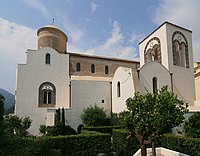San Giovanni del Toro

The Chiesa di San Giovanni del Toro (Italian: "Church of St. John of the Bull") is a church in Ravello, southern Italy.
History
[edit]Consecrated in the 11th century, the church was restored in 1715 after damage caused by an earthquake, and it was restored again in the 1990s.[1] The church is named for John the Apostle and for "Il Toro", the former name of the old aristocratic quarter in which it was built.[2] It is especially noted for its pulpit, dating from around the 13th century.
Early 20th-century English writers describe the church as in dilapidated condition,[3] stating it would have gone to ruins had it not been for government intervention in the 1880s.[4] According to these authors, who ostensibly derived their knowledge from "an old history,"[3] the consecration took place in 1069, and that the church was built by orders of one of the Dukes of Amalfi.[4]
The pulpit
[edit]The pulpit is notable for its mosaics, the decorative patterns of which inspired the interlocking patterns used by M.C. Escher,[5] who spent time in Ravello in the 1920s and studied the church and the pulpit; Ravello was one of his favorite places.[6] One mosaic is of Jonah emerging from the whale. An eagle supports the reading desk, and it holds a book opened to the first sentence of the Gospel of John. The "beautiful"[7] pulpit, which dates from the time of Roger I of Sicily,[8] also contains Oriental pottery ("underglaze-painted and lustre-painted stonepaste bowls, probably Syrian"[9]) and Arabic script,[4] and the steps up to it contain well-preserved frescoes with scenes from the life of Christ.[10] There is a side chapel with a stucco figure of Saint Catherine and her wheel.[10]
References
[edit]- ^ Murphy, Bruce; Alessandra de Rosa (2010). Frommer's The Amalfi Coast with Naples, Capri and Pompeii By Bruce Murphy, Alessandra de Rosa. Frommer's. pp. 214. ISBN 978-0-470-49734-0.
- ^ Vaughan, Herbert Millingchamp (1908). The Naples Riviera. F.A. Stokes. pp. 164.
- ^ a b Ross, Janet (1912). The fourth generation: reminiscences by Janet Ross. Charles Scribner's sons. pp. 384.
- ^ a b c E., Allen. Ravello. pp. 36–38. ISBN 978-1-113-45965-7.
- ^ Schattschneider, Doris (2004). M.C. Escher: visions of symmetry. Harry N. Abrams. pp. 12. ISBN 978-0-8109-4308-7.
- ^ Emmer, Michele (2004). Matematica E Cultura 2004. Springer. p. 248. ISBN 978-88-470-0291-3.
- ^ Shearer, Craswell (1935). The renaissance of architecture in southern Italy: a study of Frederick II of Hohenstaufen and the Capua Triumphator archway and towers. W. Heffer and Sons.
- ^ The Brochure series of architectural illustration, Vol. 1. Bates & Guild. 1895. pp. 133.
- ^ Milwright, Marcus (2009). An Introduction to Islamic Archaeology. Edinburgh University Press. p. 211. ISBN 978-0-7486-2311-2.
- ^ a b Southern Italy and Sicily: with excursions to Malta, Sardinia, Tunis, and Corfu; handbook for travellers. K. Baedeker. 1908. pp. 191.
Sources
[edit]- Gandolfo, Francesco (1999). "Il Pulpito di San Giovanni del Toro a Ravello". La scultura normanno-sveva in Campania: botteghe e modelli. Laterza. pp. 96ff. ISBN 978-88-420-5923-3.
